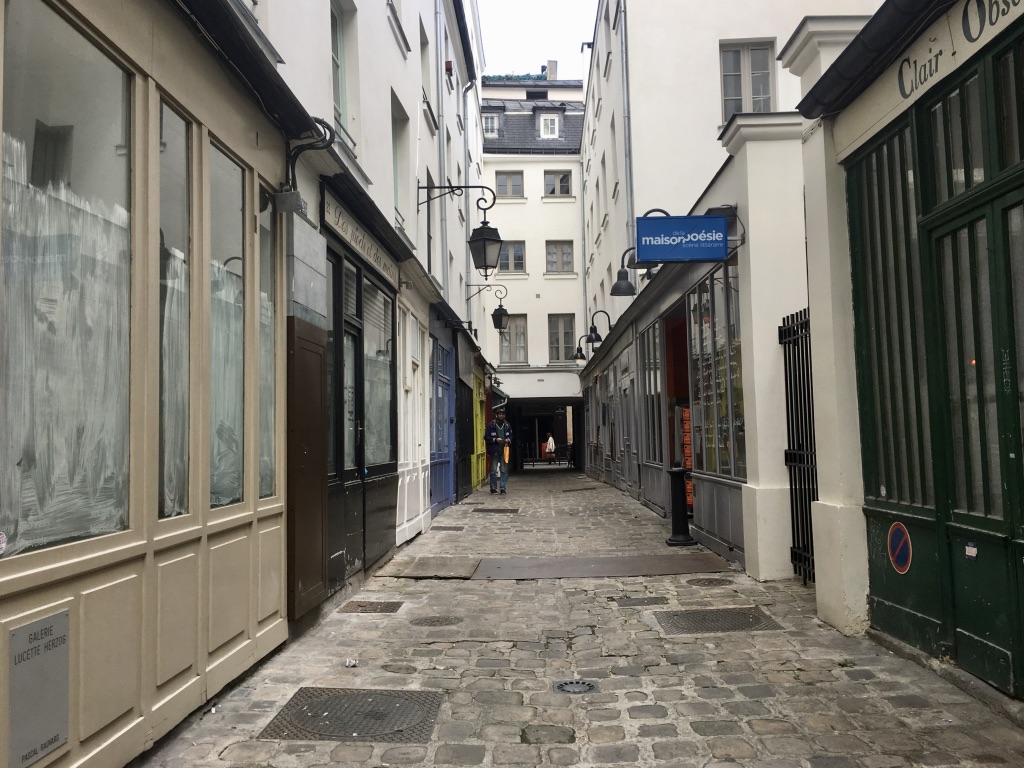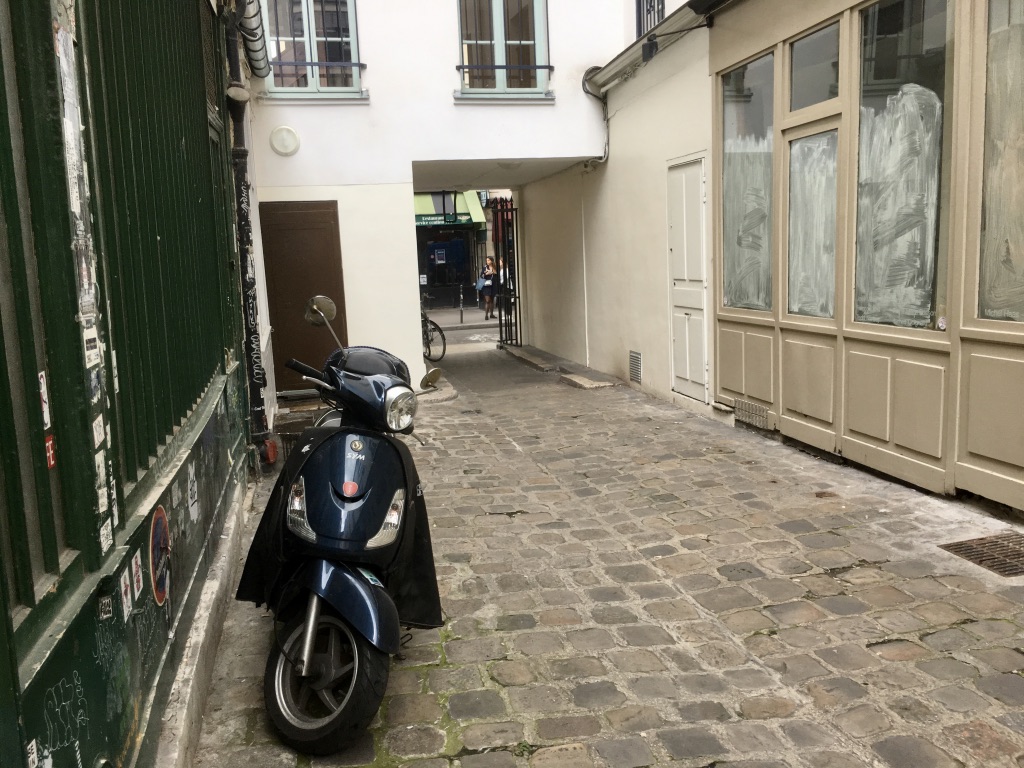The Passage Molière and its Sounds
BECAUSE IT’S NEVER HAD a roof, the Passage Molière doesn’t qualify as one of the surviving Parisian passages couverts, the covered passageways built mainly in the first half of the nineteenth century. What the Passage Molière can claim though is that it predates all the one hundred and fifty original passages couverts.

Passage Molière from rue Quincampoix
The oldest Parisian passage couvert, the Passage des Panoramas, opened in 1799 whereas the Passage Molière dates back to 1791.
The Passage des Panoramas and the Passage Molière do have something in common though: both house a theatre. The Passage des Panoramas is one of the twenty surviving passages couverts and it is still home to the Théâtre des Variétés, while the Passage Molière is home to the Théâtre Molière from which the passage takes its name.

The Théâtre Molière was founded by the French actor, playwright, theatre director, businessman and revolutionary, Jean François Boursault-Malherbe. It opened on 18th June 1791 with a performance of Molière’s The Misanthrope, a satire about the hypocrisies of French aristocratic society and the flaws that all humans possess.
Unfortunately, the theatre was not a resounding success. It closed in August 1792 and then underwent several changes of management and several changes of name, although Boursault retained the ownership. The theatre became variously known as the Théâtre des Sans-culottes, Théâtre de la rue Saint-Martin, Théâtre des Artistes en société, Théâtre des Amis des arts et de l’Opéra-Comique and Théâtre des Variétés nationales et étrangères.
The theatre’s fortunes recovered a little at the turn of the century thanks to several notable actors being persuaded to perform there including Thomas Sheridan, but in 1807 it was closed again and became a hall for concerts, banquets and balls.
The theatre opened yet again in 1831 but in the revolutionary climate of 1848 it was occupied by the Club patriotique du 7e arrondissement for political meetings and thereafter was abandoned and fell into oblivion for more than a century.
Eventually, the City of Paris authorities stepped in and restored the theatre back to its original eighteenth century architecture. Today, the theatre forms part of the Maison de la Poésie – Scène littéraire in the Passage Molière.
Founded in 1983, La Maison de la Poésie was created for the creation and dissemination of, and events about, contemporary poetry.

Sounds in the Passage Molière:

Maison de la Poésie – Scène litteraire
The Passage Molière runs in an east – west direction from 157 rue Saint-Martin to 82 rue Quincampoix. At fifty metres long it cuts through blocks of buildings with each end covered where it passes under the buildings.

Like the Théâtre Molière, the passage has had several names. During the French Revolution it became the Passage des Sans-Culottes and then the Passage des Nourrices before reverting back to Passage Molière.

I recorded the sounds in the Passage Molière from outside the Maison de la Poésie and the restored Théâtre Molière with rue Saint-Martin to my left and rue Quincampoix to my right. The passage is a relatively quiet oasis amidst the more strident sounds of the surrounding neighbourhood so all I had to do was to give the sounds time to speak and tell their own story.

Walking through the Passage Molière, the attentive observer may notice that the building numbers do not follow the Parisian street numbering convention of even numbers on one side and odd numbers on the other with the lower numbers progressing to the higher numbers in the same direction.
In the Passage Molière, the numbers progress in an anti-clockwise direction. Starting on the right side of the passage at its eastern end, the numbers increase sequentially heading west and then from the western end, the numbers continue sequentially heading east.

Passage Molière from rue Saint-Martin
Passage des Panoramas
THE PASSAGE DES PANORAMAS was opened in 1799, which makes it the oldest of the passages couverts in Paris. It takes its name from the two round towers that once stood outside in the Boulevard Montmartre. Each tower contained giant circular frescos, or Panoramas, which were very popular at the time.
The passage was built on the site of the former Hôtel Montmorency in the prestigious 2nd Arrondissement. The site became even more prestigious when the Théâtre des Variétés was built next door in 1807. In 1865, Jacques Offenbach’s La Belle Hélène premiered here. The theatre is now listed as an historical monument and it’s been fully restored to its original décor. The artist’s entrance to the theatre opens directly onto the Passage des Panoramas.
The passage comprises sixty one-story houses with boutiques on the ground floor. It was here in 1817 that the first tests of gas lighting took place.
Inside the Passage des Panoramas – Everything You Need to Know:
In 1831, the rotundas were demolished. In 1834 the passage was renovated and the architect Jean-Louis Grisart created the additional galleries, Saint-Marc, Variétés, Feydeau and Montmartre.
Today, the Passage des Panoramas has retained much of its authenticity. L’Arbe à Cannelle, today a restaurant, retains the decorated ceiling, columns and mirrors from the original chocolatier Marquis.
In 1849, the renowned graveur (printer and engraver) Maison Stern rented premises in the Passage des Panoramas. These premises are now listed as an historical monument but alas Maison Stern left some time ago.
Today the passage is renowned for its postcard and philately boutiques.
There’s even an autograph shop.
Like all the passage couverts in Paris, the Passage des Panoramas enjoyed huge early success but as competition appeared decline set in. Today, the passage retains its former nineteenth-century ambience and it seems to be as busy as ever.
Passage des Panoramas: 11 Boulevard Montmartre and 158 rue Montmartre, 75002 Paris
You can see more passages couverts here:
Les Passages Couverts
LES PASSAGES COUVERTS, or arcades as they are known in English, conjure up a wonderful picture of Paris in the first half of the nineteenth century.
The history of the passages couverts goes back to the Galerie de Bois in the Palais-Royal. Built in 1786 by Philippe d’Orléans, the Galerie was open to the public for a variety of commercial and entertainment purposes – some more savoury than others. Whilst the Galerie de Bois was built in the classical style of French public architecture of the time, the new arcades begun at the turn of the nineteenth-century represented everything that was modern.
“These arcades, a recent invention of industrial luxury, are glass-roofed, marble-panelled corridors extending through whole blocks of buildings, whose owners have joined together for such enterprises. Lining both sides of the corridors, which get their light from above, are the most elegant shops, so that the arcade is a city, a world in miniature, in which customers will find everything they need”. So says the ‘Illustrated Guide to Paris’ of 1852.
The 1820’s and 1830’s marked the heyday of the passages couverts. In all, 150 were built of which around 20 survive today.
Inside Passage Verdeau
In the early nineteenth century, the idea of ‘indoor shopping’, with a collection of shops sitting cheek by jowl offering a wide variety of merchandise, was as new as the arcades that provided it. Before the arcades appeared, shopping in Paris was a hazardous business. There were no pavements, the uncertainties of the Parisian climate and the level of street filth and mud made Paris an unsavoury place – not to mention the constant risk of death in the streets. As Baudelaire said, ‘death comes at the gallop from every direction at once’ . The concept of a group of shops, inside, under cover, was an attractive proposition to the Parisian public. I suppose we can say that these arcades were the first ‘shopping malls’ that our consumer society seems to be so much in love with today – but now we do it on an industrial scale and with far less elegance.
Inside Passage Jouffroy
In the bottom right-hand corner of the 9ème arrondissement there remain two passages couverts – the Passage Verdeau and the Passage Jouffroy. Both are on the north side of the Boulevard Montmartre. Cross that Boulevard into the 2 ème arrondissement, and directly ahead, and in line with the other two, is the Passage des Panoramas, not only the first arcade to be opened but the first to be lit by gas lamps. All three are well worth a visit.
Built in 1847, the Passage Jouffroy was the first passage couvert to be built entirely of iron and glass and the first to be heated. Throughout its life it has been home to shops selling a wide variety of merchandise – from books and post cards to La Boîte à Joujoux, with its magnificent collection of doll’s houses and all things miniature, to G. Segas, famed for its selection of walking sticks and other curiosities.
And speaking of curiosities, tucked away at one end of the Passage Jouffroy is the Hôtel Chopin. Surely one of the more curious locations for a hotel.
At the other end of the Passage Jouffroy is another curiosity, the Musée Grévin – a waxworks museum.
The decline of the passages couverts owed much to Haussmann and the Grands Magasins – the department stores – another French invention. Over the years, many of the passages couverts fell into decay and a good number disappeared altogether. Thank goodness the Passage Jouffroy and others have survived to be restored to their former glory.
Ambient recording made inside the Passage Jouffroy last Saturday afternoon

























